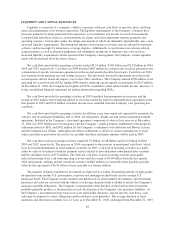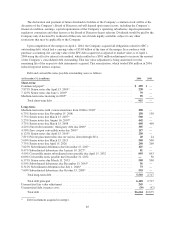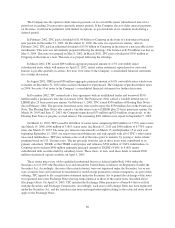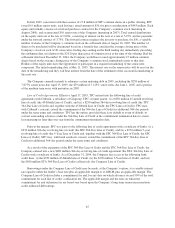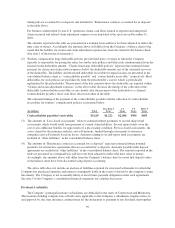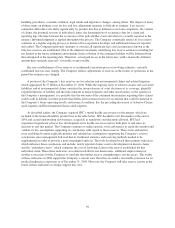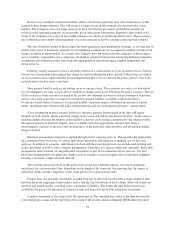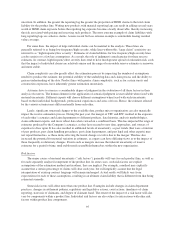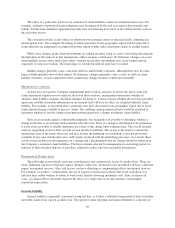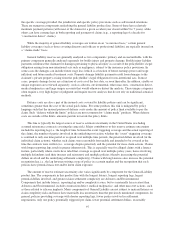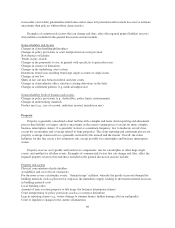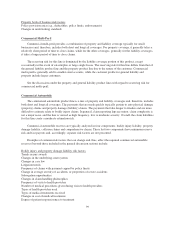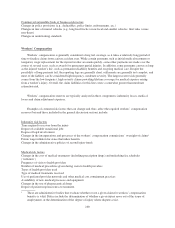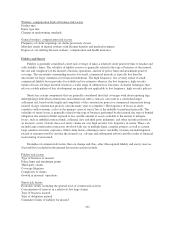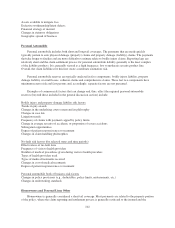Travelers 2004 Annual Report Download - page 105
Download and view the complete annual report
Please find page 105 of the 2004 Travelers annual report below. You can navigate through the pages in the report by either clicking on the pages listed below, or by using the keyword search tool below to find specific information within the annual report.
Claims and claim adjustment expense reserves by product line were as follows:
2004 2003
(at December 31, in millions) Case IBNR Total Case IBNR Total
General liability ........................... $ 8,445 $12,232 $20,677 $ 3,378 $ 7,664 $11,042
Property ................................. 1,534 1,359 2,893 685 735 1,420
Commercial multi-peril ..................... 1,979 2,216 4,195 1,325 2,059 3,384
Commercial automobile .................... 2,817 1,966 4,783 1,587 1,131 2,718
Workers’ compensation ..................... 8,313 6,658 14,971 6,207 5,081 11,288
Fidelity and surety ......................... 1,216 845 2,061 264 317 581
Personal automobile ....................... 1,484 1,219 2,703 1,286 1,097 2,383
Homeowners and personal—other ............ 470 523 993 379 537 916
International and other ..................... 2,934 2,774 5,708 354 388 742
Property-casualty ........................ 29,192 29,792 58,984 15,465 19,009 34,474
Accident and health ........................ 76 10 86 88 11 99
Claims and claim adjustment expense
reserves ............................. $29,268 $29,802 $59,070 $15,553 $19,020 $34,573
Property-casualty claims and claim adjustment expense reserves at December 31, 2004 increased by $24.51
billion over year-end 2003, primarily as a result of the merger with SPC and reserve charges recorded subsequent
to the merger. Of the increase in 2004, $19.50 billion resulted from the addition of the acquired reserves, and
$2.39 billion, net of reinsurance, was due to net unfavorable prior year reserve development primarily comprised
of $928 million to strengthen asbestos reserves primarily as a result of the completion of the Company’s annual
asbestos liability review in the fourth quarter, $290 million to strengthen environmental reserves, $800 million of
reserve adjustments related to the merger for surety and construction loss reserves, $252 million related to a
specific construction contractor, $113 million related to the commutation of agreements with a major reinsurer
and other net reserving actions. For discussion of the components of net unfavorable prior year reserve
development, see note 9 to the consolidated financial statements.
Asbestos and environmental reserves are included in the General liability, Commercial multi-peril lines and
International and other lines in the summary table. Asbestos and environmental reserves are discussed separately,
see “Asbestos Claims and Litigation”, “Environmental Claims and Litigation” and “Uncertainty Regarding
Adequacy of Asbestos and Environmental Reserves”.
General Discussion
Claim and claim adjustment expense reserves (loss reserves) represent management’s estimate of ultimate
unpaid costs of losses and loss adjustment expenses for claims that have been reported and claims that have been
incurred but not yet reported. The process for estimating these liabilities begins with the collection and analysis
of claim data. Data on individual reported claims, both current and historical, including paid amounts and
individual claim adjuster estimates, are grouped by common characteristics (“components”) and evaluated by
actuaries in their analyses of ultimate claim liabilities by product line. Such data is occasionally supplemented
with external data as available and when appropriate. The process of analyzing reserves for a component is
undertaken on a regular basis, generally quarterly, in light of continually updated information.
Multiple estimation methods are available for the analysis of ultimate claim liabilities. Each estimation
method has its own set of assumption variables and its own advantages and disadvantages, with no single
estimation method being better than the others in all situations and no one set of assumption variables being
meaningful for all product line components. The relative strengths and weaknesses of the particular estimation
methods when applied to a particular group of claims can also change over time. Therefore, the actual choice of
estimation method(s) can change with each evaluation. The estimation method(s) chosen are those that are
believed to produce the most reliable indication at that particular evaluation date for the claim liabilities being
evaluated.
93


